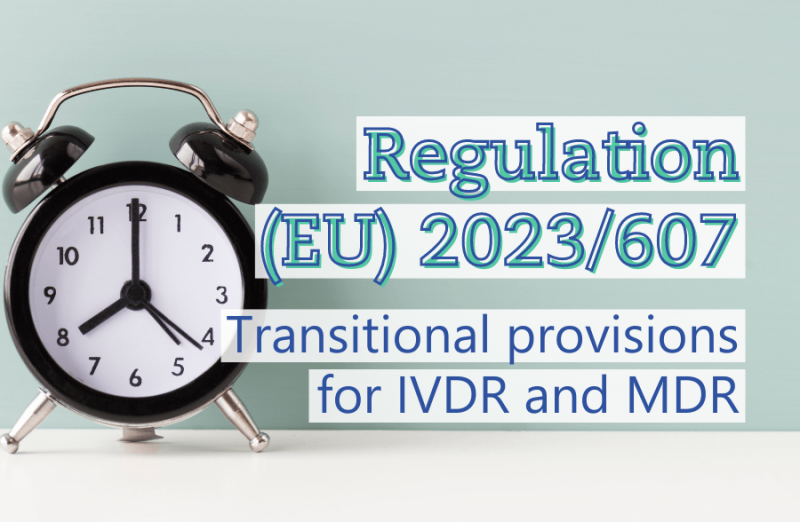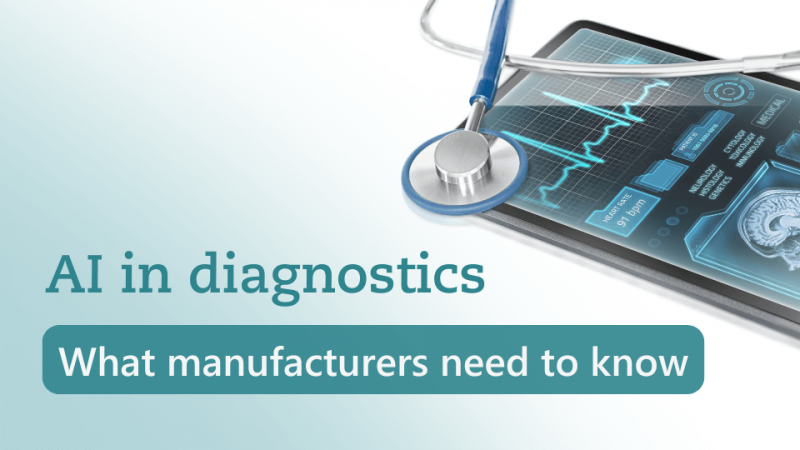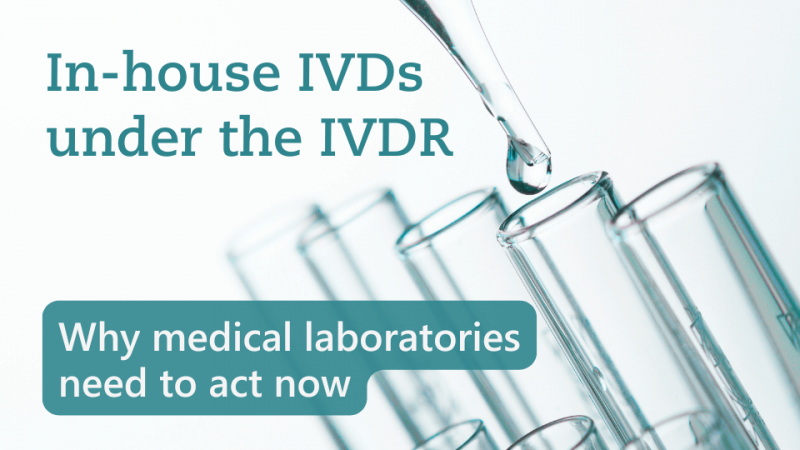Amending Regulation (EU) 2023/607: What's behind the new transitional provisions for MDR and IVDR?
31/05/2023
Do you have any questions about the article or would you like to find out more about our services? We look forward to hearing from you!Make a non-binding enquiry now
In mid-March 2023, new transitional provisions for the EU Medical Device Regulation (EU) 2017/745 (MDR) and EU In Vitro Diagnostic Medical Device Regulation (EU) 2017/746 (IVDR) came into force with Regulation (EU) 2023/607. What does the new regulation mean for manufacturers of medical devices and in vitro diagnostics (IVD)? In this article, we provide you with an overview, explain the background and answer frequently asked questions – from quality management to conformity assessment to placing the products on the market.On March 20, 2023, Regulation (EU) 2023/607 entered into force. It adapts the transitional provisions for certain medical devices so that they are still compliant with the Directives 93/42/EEC and 90/385/EEC, and that they can still be placed on the market or put into service beyond May 2024.Regulation (EU) 2023/607 also eliminates the "sell-off" period for in vitro diagnostics (IVD).We have collected nine frequent questions about Regulation (EU) 2023/607 from manufacturers, which we answer for you below:
Best Regards
 Klaus Ostermayer
Klaus Ostermayer
 Stefan Kemmann
Stefan Kemmann
- Why were the transitional provisions adapted?
- Can manufacturers now take more time with the conformity assessment according to MDR?
- What does the elimination of the so-called "sell-off" rule mean?
- Which new regulations apply to certificates issued regarding Directives 90/385/EEC or 93/42/EEC?
- What new rules apply to certificates that were issued on or after May 25, 2017, and were still valid on May 26, 2021, but expired before the Amending Regulation (EU) 2023/607 became effective on March 20, 2023?
- What are the deadlines now for legacy devices that are not being continued?
- What else applies to placing legacy devices on the market?
- What should a formal application for conformity assessment contain?
- What about the monitoring of the extended policy certificates?
1 Why were the transitional provisions adapted?
The European Commission's proposal to amend the transitional provision of January 2023 has already entered into force on March 20, 2023, as Regulation (EU) 2023/607. There are numerous valid reasons behind this rapid action, for example:- limited available capacities at the Notified Bodies,
- several thousand certificates (as of the end of 2022) that would still have had to be reissued by May 2024 regarding the MDR,
- feedback from the EU market on imminent bottlenecks in the availability of medical devices.
2 Can manufacturers now take more time with the conformity assessment according to MDR?
One important clarification up front: MDR compliance must be initiated.Some manufacturers may have hoped that deadlines for implementing MDR requirements would be extended beyond May 2024. That hope has been dashed with the new transitional provisions. They must continue to adhere to their implementation plan and must have completed critical steps regarding MDR conformity assessment by May 2024 to continue to place products on the market. This includes, for example, implementing a quality management system (QMS) that meets MDR requirements. The unchanged timeline is made unmistakably clear by the objective and the explanatory memorandum of Regulation (EU) 2023/607: the sole aim is to ensure the availability of medical devices, and to minimize the risk of supply shortages for medical devices and in vitro diagnostics (IVD).3 What does the elimination of the so-called "sell-off" rule mean?
The elimination of the sell-off period applies to all legacy devices and relates to both MDR and IVDR. This refers to products.- that still complies with Directives 93/42/EEC or 98/79/EC, and
- that have already been or will be placed on the market under the applicable transitional provisions according to MDR and IVDR.
- products placed on the market under the respective directives prior to May 26, 2021 (MDR) and May 26, 2022 (IVDR), as well as
- legacy devices placed on the market under the transitional provisions of the MDR or IVDR.
4 Which new regulations apply to certificates issued regarding Directives 90/385/EEC or 93/42/EEC?
- Certificates issued on or after May 25, 2017, that were still valid on May 26, 2021, and that have not subsequently been withdrawn shall continue to be valid until a date related to the risk class of the device:
- Under the specified conditions, certificates are valid until December 31, 2027, for Class III devices and Class IIb implantable devices (excluding sutures, braces, dental fillings, dental braces, dental crowns, screws, wedges, dental or bone plates, wires, pins, clamps, and connectors).
- Under the specified conditions, certificates are valid until December 31, 2028, for other Class IIb devices, Class IIa devices, and Class I devices (to be placed on the market in a sterile condition or with a measuring function).
- Devices, for which the conformity assessment
- According to Directive 93/42/EEC did not previously require the involvement of a Notified Body,
- was already issued before May 26, 2021, and
- requires the involvement of a Notified Body in accordance with the Medical Devices Ordinance (e.g., reusable surgical instruments)
5 What new rules apply to certificates that were issued on or after May 25, 2017, and were still valid on May 26, 2021, but expired before the Amending Regulation (EU) 2023/607 became effective on March 20, 2023?
For these certificates, the mentioned longer validity periods related to the risk class of the product are only valid if one of the following conditions applies:- The manufacturer concerned has already signed a written agreement with a Notified Body for a conformity assessment before the end of the validity of the certificate – either for the product covered by the expired certificate or for a product intended to replace this "expired" product.
- A competent authority of a Member State has granted an exemption from the applicable conformity assessment procedure or has requested the manufacturer to carry out the applicable conformity assessment procedure (these procedures would then be in accordance with Article 59(1) MDR or Article 97(1) MDR).
6 What are the deadlines now for legacy devices that are not being continued?
In short, if there is no intention for products to continue under the MDR or be replaced by successor products after May 26, 2024, a manufacturer will not bother with a conformity assessment procedure under the MDR. This means that certificates issued under Directives 90/385/EEC or 93/42/EEC will lose their validity by May 27, 2024, at the latest. This means that from then on, placing on the market and further provision on the market will no longer be possible.7 What else applies to placing legacy devices on the market?
In addition to these transitional provisions, other legacy provisions are important, including:- The products must continue to comply with Directive 90/385/EEC or Directive 93/42/EEC.
- There are no significant changes in design and intended purpose (see also MDCG 2020-3).
- The devices do not pose an unacceptable risk to the health or safety of patients, users or other persons or to other aspects of public health protection.
- The manufacturer has established a quality management system (QMS) in accordance with Article 10(9) of the MDR by no later than May 26, 2024.
- The manufacturer (or authorized representative) has submitted a formal application for conformity assessment to a Notified Body for the legacy device or for a device replacing the legacy device no later than May 26, 2024, and the Notified Body and the manufacturer have signed a written agreement on conformity assessment no later than September 26, 2024.
8 What should a formal application for conformity assessment contain?
At the end of March 2023, the EU Commission published a Q&A document. This states the following requirements that should be met for a formal application:- The application must include the quality management system (QMS) documentation but not the technical documentation for each product that is to be the subject of the requested conformity assessment procedure.
- The application shall clarify which products are to be the subject of the conformity assessment.
- The application must clearly state which MDR products are to replace which legacy devices.
- The application must enable the Notified Body to identify all devices listed in the application as medical devices.
- Ideally, the manufacturer should include a plan showing when the technical documentation (or other relevant information) required for the conformity assessment will be available.
9 What about the monitoring of the extended policy certificates?
In principle, the Notified Body that issued certificates under 90/385/EEC or 93/42/EEC remains responsible for surveillance. This principle does not apply if the manufacturer makes an agreement with a Notified Body under the MDR to take over the surveillance.At the latest from September 26, 2024, the Notified Body responsible for surveillance will be the one that has entered into the written agreement with the manufacturer for the conformity assessment of those devices that will remain under the MDR or that will replace the legacy devices.Conslusion
With Regulation (EU) 2023/607, new transitional provisions came into force in mid-March 2023. The sell-off period for so-called legacy products no longer applies, and there are some changes under certain conditions regarding the validity period of certificates according to 90/385/EEC or 93/42/EEC. However, there is no time relief in terms of the implementation plan for the conformity assessment according to MDR. Manufacturers of medical devices and in vitro diagnostics (IVD) must have completed the decisive steps for this by May 2024 - for example, the establishment of an MDR-compliant quality management system (QMS).Have you recognized yourself with your products in the scenarios described? Are you currently considering how to deal with your legacy products? Or is your implementation plan for MDR conformity assessment currently stalling? Feel free to contact our team and discuss your MDR status or IVDR status with us in a non-binding and free initial meeting. We look forward to finding individual solutions together with you.Best Regards
Our blog posts are researched and created with the utmost care, but are only snapshots of the regulations, which are constantly changing. We do not guarantee that older content is still current or meaningful. If you are not sure whether the article you have read on this page still corresponds to the current state of regulation, please contact us: we will quickly place your topic in the current context.

Expert Quality Management
Systems & Auditing

Medical Device Expert
Regulatory Affairs & Technical Documentation


